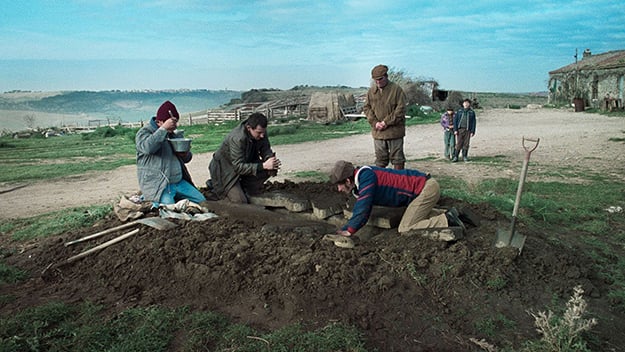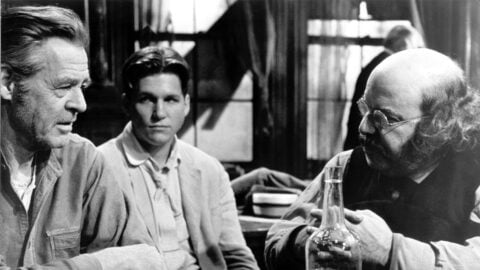Can You Dig It?
This article appeared in the April 12, 2024 edition of The Film Comment Letter, our free weekly newsletter featuring original film criticism and writing. Sign up for the Letter here.

La chimera (Alice Rohrwacher, 2023)
La chimera opens in the harsh glare of the sun, a first for a film by Alice Rohrwacher. Light pierces a pane of glass; a woman squints at the camera and asks: “Can you see that the sun is following us?” She may be a dream: bathed in that pristine afternoon light is Josh O’Connor’s Arthur, his head resting against the window of a moving train, a shadow passing diagonally across his face. The cool, blue nights that inaugurate Rohrwacher’s previous features, Corpo celeste (2011), The Wonders (2014), and Happy as Lazzaro (2018), set us up for quests of enlightenment; in some of them, characters are explicitly looking for a bulb or a switch, a source of illumination. In La chimera, the light of day is too bright, too unkind. From the very beginning, we crave the dark of the underworld where the film’s tombaroli, or tomb-robbers, do their shady business.
The tombaroli are thieves. In Italy, antiques are abundant, a source of national pride, and also closely guarded. Laws deem artifacts of cultural or historic value found on Italian soil to be state property, and a special enforcement agency, the carabinieri “art squad,” fights the black market where unearthed goods are smuggled to international collectors and galleries for preposterous sums. The tombaroli are violators of these laws. But for Rohrwacher, it is their violation of the sacred that was the draw—the fact that they fearlessly plumb the depths of the earth and wrench open the realms of the dead, so they can “enter a space that was created not for the eyes of men, and take it away, take it to the sunlight.”
The tombaroli of La chimera sniff out the rock-cut tombs of the Etruscans, an ancient Italian people who buried their dead in elaborately designed crypts with frescoes, sculptures, and luscious grave goods. When the robbers enter one such centuries-old tomb in the film, and a ray of sun, sparkling with dust particles, slices through the chilly dark, a quote from The Communist Manifesto came to my mind. “All that is solid melts into air, all that is holy is profaned, and man is at last compelled to face with sober senses his real conditions of life, and his relations with his kind,” wrote Karl Marx and Friedrich Engels in 1848, lamenting how capitalism, and its relentless quest for innovation, engineers a kind of disenchantment, a severing of people from the communal traditions that give meaning to life. If quoting Marx seems too on-the-nose, it is in line with Rohrwacher’s M.O. She trades in fables and icons—in broad, blunt narratives that draw upon resilient myths and color them in with intricate contemporary detail. Her films are all about thieving of one kind or another: the petty swindles of laborers, churchgoers, peasants, and crooks; and the grand, state-sanctioned ones of the church, the media, and landowners. Myth is corrupted by money; all that is holy is profaned.
In Corpo celeste, a car swerves on a mountain road, and the stolen crucifix it is ferrying drops comically (cosmically?) into the sea below. In Happy as Lazzaro, a young peasant survives a deathly fall and moves unchanged through time, like a saint, only to be mistaken for a robber and die at the altar of finance—the local bank. A struggling pastoral family of beekeepers finagles its way into a TV competition show in The Wonders, and finds that it is not their painstaking manual toils and organic honey they’re supposed to shill, but hollow, gilded fantasies of ancient life on the land. In La chimera, Arthur is something of a fallen angel, emerging from prison in a smudged white suit in the film’s first act. We know little about his origins, except that he is an English archaeologist who fell in with a group of rugged tombaroli in Tuscany, and who chases the dream of reuniting with a long-lost lover, Beniamina, sharing the delusion of her return with the girl’s mother, played by Isabella Rossellini.
Within days of Arthur’s return, he is back to his old ways, punting about the blue-green countryside with his merry crew, chasing the thrill of excavation, discovery, and smuggling. The group sings songs as they go about their business. Not everyone is capable of defying the laws, the darkness, the souls of the dead / Some people are scared of dying, and others are for adventure bred . . . Just think, folks, what the law is for / to protect those who exploit your labor. Unlike in Lazzaro, here we do not need to see these men (and a few women) suffer to know that their thieving is righteous. They are irreverent and playful, tricksters as much as noble proletarian vindicators. Cinematographer Hélène Louvart switches between 35mm and tinted 16mm, and Rohrwacher occasionally speeds up these sequences, like montages in a silent movie. Time moves differently when you steal from the dead for a living.
But these flourishes also remind us that pastness is an affectation, and history as much an aesthetic as a measure of temporal distance. La chimera is set in the 1980s, but time feels fluid and uncertain, as in most of Rohrwacher’s work. Late in the movie, we meet the mysterious buyer of the tombaroli’s spoils, Spartaco (I won’t spoil the identity of the actress, a mordant surprise), who has at her disposal drills and cranes, and a yacht where she peddles the goods dug out by the grave-robbers, dirt under their nails, to manicured audiences of international collectors. Around a gorgeous Etruscan sculpture that she has stolen from the stealers using an elaborate deception, she crafts a beguiling story and invites her deep-pocketed buyers to name a price—to “estimate the inestimable.”
How does one estimate the “value” of culture? Since 1909, Italy has had national patrimony legislation that makes any object of cultural value older than 50 years found on or below the ground—whether movable or immovable—to be public property. The government has ownership of these artifacts and also bears the responsibility of their protection and “valorization,” meaning the expansion of their cultural value. In 2008, a constitutional amendment initiated by Silvio Berlusconi made an important change. Protection remained under state purview, but private investment was permitted for valorization. In 2011, Tod’s, a luxury goods company, struck up a $30 million partnership with the state to renovate the Colosseum in exchange for limited advertising rights. Five years later, Tod’s held a concert in the 1,944-year-old monument to celebrate the completion of the first phase of refurbishment.
To many commentators in Italy, this “synergy between the state and the private citizen,” as the Italian Ministry of Culture put it, was no less than theft in plain daylight. The below-world market of the tombaroli and Spartaco operates like a shadow of the above-world market of the state and its corporate friends. Both rely on culture’s conversion to capital, and both can only exist in a world premised on inequity, where the value of an artifact is determined not by its beauty or accumulation of history, but by a chimeric quality: the desire of the wealthy to own it. Can anything be sacred in such an unequal world? For all their death-defying bravado, the tombaroli work like any other wage laborers, toiling to sell away the wares buried in their own land at terms set by the rich.
Their foil in La chimera is Italia (Carol Duarte), a student of Rossellini’s foreboding matriarch, Flora. Naïve, exuberant, and devoutly religious, Italia balks at tomb-robbing, but later in the film, she partakes in a reclamation of a different kind. Encountering an abandoned train station that Flora describes as public property, Italia is confused. “Does it belong to everyone or no one?” She has two children and no home, and eventually squats at the train station with other local women, turning it into a feminist commune of sorts. It’s a microcosm outside of the world of the tombaroli, collectors, renters, and employers: a small utopia where one’s basic needs can be met without the alienating transactions of the market.
Arthur, meanwhile, is rapt in his visions. The romance of the hunt is a theme in tombaroli lore—Pietro Casasanta, whom The Wall Street Journal described as the “Prince of the Tomb Robbers,” said of digging the land he knows so well for treasures, “It’s like falling in love with a woman, it’s hopeless.” Yet Arthur, the Englishman, is not of the land. O’Connor’s casting in La chimera isn’t a canny appeal to international funders and audiences but rather another brilliant deployment of archetype by Rohrwacher: he is the exemplar of the young foreign professionals who arrive in Italy with official licenses, burrowing in the backyards of the tombaroli in the hallowed name of knowledge. Spartaco tells him that no matter how much he slums it with the robbers, who dig to survive, he won’t be one of them.
Blessed with a seemingly divine gift for dowsing—or is it an act?—Arthur chases fantasies of sacredness in a disenchanted world, and ends up betraying both his comrades and (the pointedly named) Italia. He is returned to netherwordly darkness at the close of the film, shut away in a crypt, chasing a blip of sunlight that may be an escape, or more likely, an illusion. All that is solid melts into air; all that is holy is profaned.
The author would like to credit Ruling Culture: Art Police, Tomb Robbers, and the Rise of Cultural Power in Italy (Fiona Greenland, University of Chicago Press) for crucial historical context.
Devika Girish is the Editor of Film Comment and a Talks programmer for the New York Film Festival.







